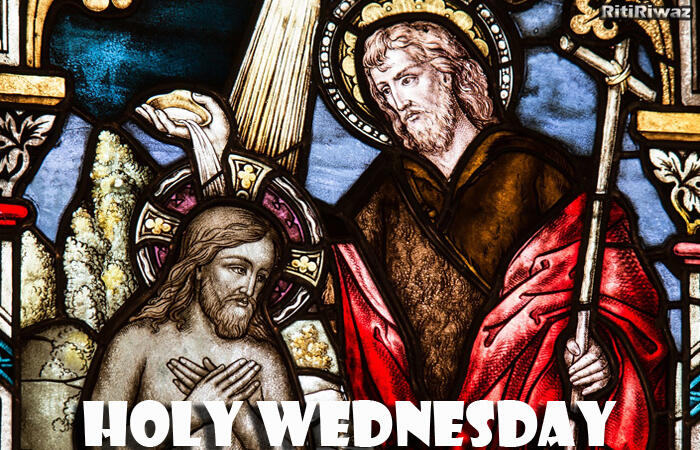Jharkhand Culture and Tradition

Jharkhand is an eastern state of India, which was carved from the southern part of Bihar on 15th November 2000 after a long and protracted demand for a separate State. Jharkhand borders state of Bihar in the north, Uttar Pradesh and Chhattisgarh in the west, Odisha in the south and West Bengal in the east.
Jharkhand is the fourteen largest state in terms of population and the 15th largest state in terms of area. Ranchi is the capital and Dumka is the sub-capital of the state while Jamshedpur is the largest and the biggest industrial city of the state. Some of the other major cities and industrial centers are Dhanbad, Bokaro, and Hazaribagh.
Due to its abundant mineral reserves, it is also called as “Rur of India“, Rur is a mineral state. Jharkhand has more than 40 percent mineral wealth of the country, and mining and mineral extraction are the major industries in the state. Jharkhand is famous for its rich mineral resources like Uranium, Mica, Bauxite, Granite, Gold, Silver, Graphite, Magnetite, Dolomite, Fireclay, Quartz, Feldspar, Coal (32% of India), Iron, Copper (25%of India), etc.
Despite having so much mineral wealth 40 percent of the population of this state is below the poverty line. The majority of the population of the state is in rural areas only 24 percent of people lives in cities. The rural population is dependent on agriculture and rice is the major crop cultivated in the state.
The name “Jharkhand” means “The Land of Forests” as the most of land is covered by forest. Jharkhand has underlined the distinctive tribal heritage and culture of the region as the primary reason for alternative administrative and political arrangements.
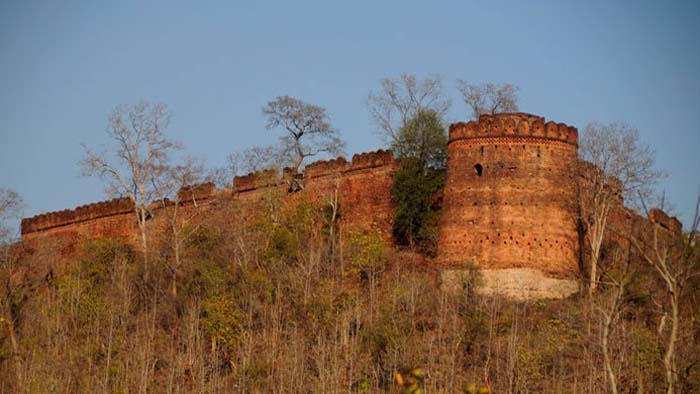
History
Jharkhand has a unique geographical, demographic and historical composition. According to some historians, there was already a distinct geo-political & cultural entity in the area which we know as Jharkhand even before the period of the Magadha Empire.
The description of Jharkhand is also found in the Vedic books, Jharkhand is called Muranad in Vayu Purana and it is known as Mund in Vishnu Purana. The Chota Nagpur region was known as Pundarik during the Mahabharat period. In some Buddhist texts, there is a description of Chinese Buddhist monk Faxian coming to India. Faxian was a Chinese Buddhist monk who traveled by foot from China to India, visiting many sacred Buddhist sites. Jharkhand has also been described by the Chinese traveler Yuwan Chwang, the Iranian traveler Abdul Latif and the Iranian religious teacher, Mullah Bahbahani.
History of Jharkhand state is more than 100 years old, Indian hockey player and captain of the Indian hockey team in Olympic Games, Jai Singh Munda, in 1939 AD, thought of merging some southern districts of present Bihar state into a new state. However, this dream of Jai Singh Munda came true on 2 October 2000 when the bill to give separate statehood status to Jharkhand was passed in the Parliament, and then on 15 November the same year, Jharkhand became the 28th state of India.
Historians believe that this region was also marked as a unit even before the Magadha Empire because the geographical, cultural identity of the region was different. The state of Jharkhand is considered to be a natural place for tribal communities, who have been given the status of Scheduled Tribes in the Indian Constitution.
Among them, Khadia, Santal, Munda, Ho, Oraon, Asura, Birjia, Pahadia, etc. are prominent. The credit of making the forests of Jharkhand clean and cultivable and habitable to humans is given to these tribal.
Before the Muslim rulers and the British rule, the tribal took over the system here. In the Munda practice of these tribal, a head was appointed in the village called Munda and the messenger of the village was called Dakuva. Later during the Mughal Sultanate, this state came to be known as Kukra State.
After the year 1765, this area came under the British Empire. During the subjugation of the British Empire, the tribal of this place were tortured a lot and the influence of the people coming from outside increased. Due to increasing atrocities, day by day many revolts were also carried out by the tribal, some of which are as follows.
Paharia revolt
The Paharia movement was started by the tribals of the state of Jharkhand against the increasing British atrocities on them, which lasted from the year 1772 to 1780.
Manjhi revolt
Tilka Manjhi was a tribal Yodha who raised her voice against the atrocities of the British rule. Tilka Manjhi was born on 11 February 1750, Tilka continued her rebellion against the British power from 1772 to 1784 without any surrender. Manjhi started a rebellion against the atrocities of the British Empire, which was called Manjhi rebellion, this rebellion lasted from 1780 to 1785.
Tamar revolt
This revolt was led by Dukhan Manki and this revolt lasted from 1795 to 1800 AD.
Munda revolt
This rebellion was led by Vishnu Manki and this rebellion also-ran like the Tamar rebellion from 1795 to 1800 AD.
Munda revolt under the stewardship of Dukhan Manaki of Tamar
The Munda tribes have periodically launched movements against the atrocities of the British Empire in the state of Jharkhand, in the same order, there was a rebellion by Dukhan Manki which lasted from 1800 to 1802 AD.
Chero revolt
Like all rebellions, this rebellion was against the British rule, it was started by Bhukan Singh of Palamu.
Bhumij revolt
Bhumij revolt under the leadership of Ganga Narain of Birbhum started in 1832 and continued till 1833.
Santhals revolt
The Santhal tribes, which are mainly found in Jharkhand, West Bengal, Orissa and Assam, revolt against the Governor of Bengal, Lord Cornwallis. This rebellion was called the revolt of the Santhals.
Second Santhals revolt
The second revolt of the Santhals was done under the leadership of Sidhu Kanhu. This revolt started in 1855 and lasted till 1860.
Sepoy Mutiny.
This rebellion was the first armed rebellion against the British Empire led by Shaheed Lal, Vishwanath Sahadeva, Sheikh Beggars, Ganpat Rai, and Budhu Bir. This rebellion started with arson and sabotage but the rebellion took a huge form. And by the end of this rebellion, the rule of the East India Company had ended and the direct rule of the British crown began.
Kherwar Movement
The Kherwar movement was started in 1874 under the leadership of Bhagirath Manjhi. Bhagirath Manjhi was the son of Tilka Manjhi. Tilka Manjhi was hanged for waging a rebellion against the British Empire, after which Bhagirath Manjhi led the Kherwar movement.
Munda Revolt
This rebellion was also part of the Munda rebellion which was carried out by the Munda tribe from the 18th century to the 20th century. This rebellion was led by Birsa Munda, Birsa was born at a place called Ulihatu in Jharkhand. There was a great movement called Ulgulan in Jharkhand under the leadership of Birsa, people of the Munda tribe still worship Birsa as God.

Apart from all these revolts, many more revolts were carried out against the British Empire but they were made useless by the Indian British Army. Mahatma Gandhi was greatly influenced by Tana Bhagat heartening freedom struggle, and after which Mahatma Gandhi started the Civil Disobedience Movement
In the year 1765, this area became subordinate to the British Empire, the East India Company started enslaving the people of Jharkhand region and started oppressing them, as a result of which the people of the region got a sense of rebellion against the British Empire. The revolt against the British broke out in 1857, but the tribal here started a revolt against the British almost 100 years ago.
The tribal made several revolts from the British Empire to protect the land of Jharkhand. Tilka Manjhi first waged a revolt against the British Empire, in 1796, a tribal leader Sant Lal redeemed his land from the landlords and the British Government and Pledged to restore the land of ancestors. The British government sent its troops and crushed the revolt of Tilka Manjhi
In 1797, other tribes also revolted against British rule. After this, the people of the Chero tribe in Palamu started a revolt against the British Empire in 1800 AD. Seven years after this rebellion, in 1807 AD, Orens killed their great master of Srinagar in the west of Gumla in the Barway. This thing soon spread to Gumla and surrounding areas. People of the nearby Munda tribe and people spread in Tamar areas also revolted against the British Raj.
In the Revolt of 1813, Gulab Singh was holding a land transaction but then in 1820 he openly started rebelling against the landlords and the British. It was known as Laka Coal Rings 1820 -1821. Then came the great Cole Rising and this rebellion was done in 1832. This rebellion was a major revolt by the tribes of Jharkhand, this rebellion greatly disturbed the British Empire. In 1855, the Santhal Rebellion started under the leadership of two brothers Santhal and Kannu. These rebels greatly disturbed the British rule, but then later the British government also crushed them.
After all this, the rebellion of Birsa Munda started. In this rebellion, the people of the Munda tribe revolted in Khunti, Tamar, Sarwara and Badgaon belts. Munda Rebellion was the largest and longest-running tribal uprising of Jharkhand.
In the Chota Nagpur division, the British government faced many rebellions, the opponents of the British government adopted the policy of divide and rule wherever they existed. The British government tried its best to suppress and rule the tribals, but the tribals also strongly opposed it and protected their wretches.
After the Chhotanagpur Tenancy Act 1908 to protect their land, the tribals thought of doing social and economic development of the people and in 1920 joined the Satyagraha movement of Mahatma Gandhi and stopped the government from giving the land. The Simon Commission came to Patna in 1928 when the tribals demanded a separate Jharkhand state, but their demand was turned down. After this, Thabal Oron organized the Kisan Sabha in 1931 and then in 1935, the Unnati Samaj and the Kisan Sabha were merged in Chautalagpur to gain political power.
Culture and Tradition of Jharkhand

Many tribes have inhabited this part of the country because of which the state has emerged as an important multi-ethnic state. Jharkhand has about thirty indigenous communities among which some of the major tribes are the Santhals, Oraons, Mundas, Kharias, Hos, and Cheros.
The state is a blend of various tribal cultures, people are influenced by Buddhism and Jainism, the Mughals and Hindu kings. The culture of the people depends on the community to which they belong, which influences there living style, rituals, dance, music, language, and literature.
Being a tribe dominated state each sub-caste and tribe have its own unique tradition. Nature has been given the utmost importance in every sphere of life and culture. The life of tribal people is reflected in their folk dances, paintings, music, dance, and drama.
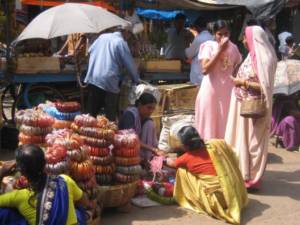
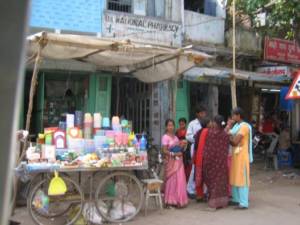
The state is situated on Chota Nagpur Plateau with many rivers like Damodar, Brahmani, Kharkai, and the Subarnarekha, flowing gently adding natural beauty and the taste of the elegance of nature. Jharkhand is a place to explore the mild hills, valleys, and riverbeds with endless opportunities for exploration.
Jharkhand is one of the richest regions of India in mineral resources, about 40% of the country’s mineral wealth is found here but the region is still plagued by poverty, social injustice, corruption, and sporadic outbursts of Maoist and Naxalite violence. Although with the influence of modernization things are changing fast, still the tribal people have retained their traditional way of life.
Suggested Read: Culture and Tradition of Indian States
Festivals

The communities of Jharkhand have a rich culture and tradition with several colorful festivals. Branches of scared trees are brought and ceremonially planted in the courtyards. Devotees then worship these tree parts associated with gods and goddesses. Karma puja, Jitis puja, Sarhul are a few of these examples.
Poush Mela or Tusu Fair is a significant occasion celebrated during the Makar Sankranti wherein brightly colored and decorated artifacts of folk deity are carried by the people. This is a folk harvesting festival. Tusu is a folk belief, not about any God or Goddess, but about a sweet little girl of the tribal folk. The festival takes place as new crops are harvested.
Language
The official language of Jharkhand is Hindi and is mostly spoken among people while the state converse in a number of other languages like Bengali, Angika, Kurukh, Mundari, Santali, and Ho.
Cuisine

The popular cuisines include local varieties such as Arsa, Dhuska, Chhilka, Koinar Sag, Grenn Sag, Dubki, Udad Dal, Kurthi Dal, Litti-Chokha, Sattu Paratha, Pitha, Khapada, Roti, Arsa, Mitha Pitha, and Kudurum Ki Chatni are famous. The food is not much different from its neighboring states Bihar. They prefer to eat wheat, rice, and vegetable cooked in Sunflower Oil and Mustard Oil.
Dhuska is a dish made from rice. Dhuska is prevalent in tribal houses. Some of the non-vegeterian food are Mudwa Khussi Meat, Duck Meat, Deshi Chicken and Tengara Fee.
Litti is famous dish of Jharkhand served with Baigan bharta and Aloo Bharta. Jharkhand Pitta is made of rice and has its own flavor. Rugdha, Chilka Roti, Mal-Pua, Bamboo-shoots, ThekuaAaloo Chokha, Till Barfi and Khaja are also very popular.
Suggested Read: Famous Food Of Indian States
Costumes
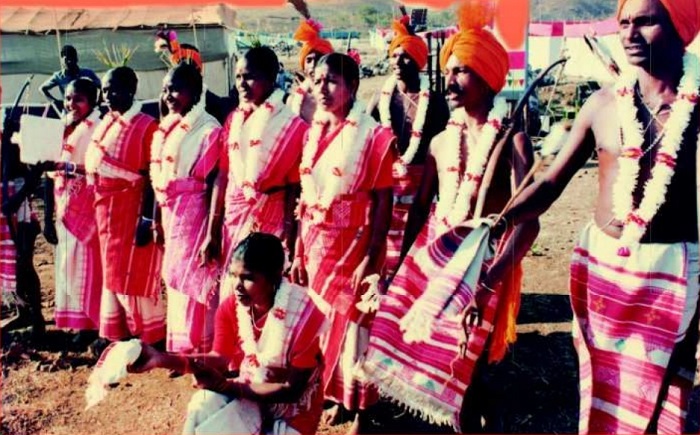
The women’s clothing in Jharkhand is saree and blouse, you can find high-class Tussar silk sarees here. Tribal women usually wear Parthan and Panchi. While the non-tribal women wear modern costumes or sari with a blouse. Women love to wear gold and silver jewelry which are mostly beaded ornaments.
Bhagwan is a single piece of cloth worn by men. The Santhal Pargana tribe men wear Santhals and Paharis to give them a unique look. While men also wear kurta -pyjama or dhoti while shirts and trousers are also worn.
People of Jharkhand harbor a love for perfumes and their aromas and you can find people applying a variety of perfumes.
Suggested Read: Traditional Dresses Of Indian States
Music and Dance

Tribal people of Jharkhand (Mundas, Santhals, and Oraon) are born dancers and singers. There are song and dance at every get-together, they have their own musical instruments and the traditional tribal costumes and jewelry worn by the dancers.
Some of the popular tribal dance of Jharkhand are Hunta Dance, Mundari Dance, Barao Dance, Jitia Karam, Jenana Jhumur, Mardani Jhumur, Seraikella Chhau, Ghora Naach, Domkach, Laha Suya, Jhitka and Danga.
Paintings

The Jharkhand area is famous for a special type of folk painting called the paitkar paintings. This form of painting is one of the earliest forms of tribal paintings in India and thus enhances the culture of Jharkhand.
Crafts

Jharkhand is a treasure house of arts and crafts and hand-looms. You can find clay elephants, pots painted in brilliant hues and embellished with rural motifs, foot-scrubbers, clay figurines, jugs and masks of variety.
During Navratri Bengali craftsmen flock Jharkhand to make idols of Durga, Kali, Saraswati, and other deities, from bamboo, straw, clay colors, tinsel, pith, and other decorations. The ‘painted mask’ tradition of Jharkhand is truly legendary. In the early days, masks were made of leaves, but today’s highly stylized masks use a variety of materials like wood, pumpkin, gourd, cloth, even paper masks.
Dokra, the ancient metal crafts which have caught the interest and attention of the worldwide artistic community, is practiced by the Malhar and Tentri tribes of Jharkhand.
Tourism

Go to Jharkhand, and explore the mild hills, valleys, and riverbeds, the mines and minerals are aplenty but so are the beautiful things. You will find amazing people outside the cities, the local brew is called handia, Sal Forests, Project Tiger at Betla, the Kechki river confluence near Betla, then Netarhat, Amjhoria, Horhap. The tourist facility is minimal and you will find very few tourists in the area.
There are numerous mountains, ghats, waterfalls, nature and the wide undisturbed coastline that make it a heaven for anyone with a desire for natural beauty. In Jacinta falls will find quiet bubbling waterfall, very safe, not too much water, some great rock climbing around it, the water is clean enough to drink and if water can taste heavenly.
Baidyanath Dham – One of the 22 Jyotirlingas of Shiva.
Jain pilgrimage center at Parasnath Hill
Betla (Palamau) National Park
Jubilee Park – Unique Park built on the Golden Jubilee of Tata Steel.
Shikharji mountain peak – the highest peak in Jharkhand.
Methon Dam – one of the 10 tallest dams in the country.
Rock Neck – one of the most beautiful gardens in the country
Naulakha Temple – Built at a cost of nine lakhs
Hundru waterfall – the tallest waterfall of Jharkhand at 98 meters high.
Tata Steel Zoological Park – Wild Animal Park
Betla National Park – Tiger Reserve located in the Chota Nagpur Plateau.
Hazari Lake – Velvet meadows located in Hazaribagh
Kanhari Hill – Beautiful view of the entire Hazaribagh from the towering tower
Surajkund – Hazaribagh hot water reservoir
Famous people from Jharkhand state
Mahendra Singh Dhoni – Famous Cricketer (born in Ranchi)
Meenakshi Sheshadri – Hindi film actress (born in Sindri)
Priyanka Chopra – Famous Hindi film actress (born in Jamshedpur)
Tanushree Dutta – Famous Bollywood Actress (born in Jamshedpur)
Suggested Read: Formation Dates of Indian States


